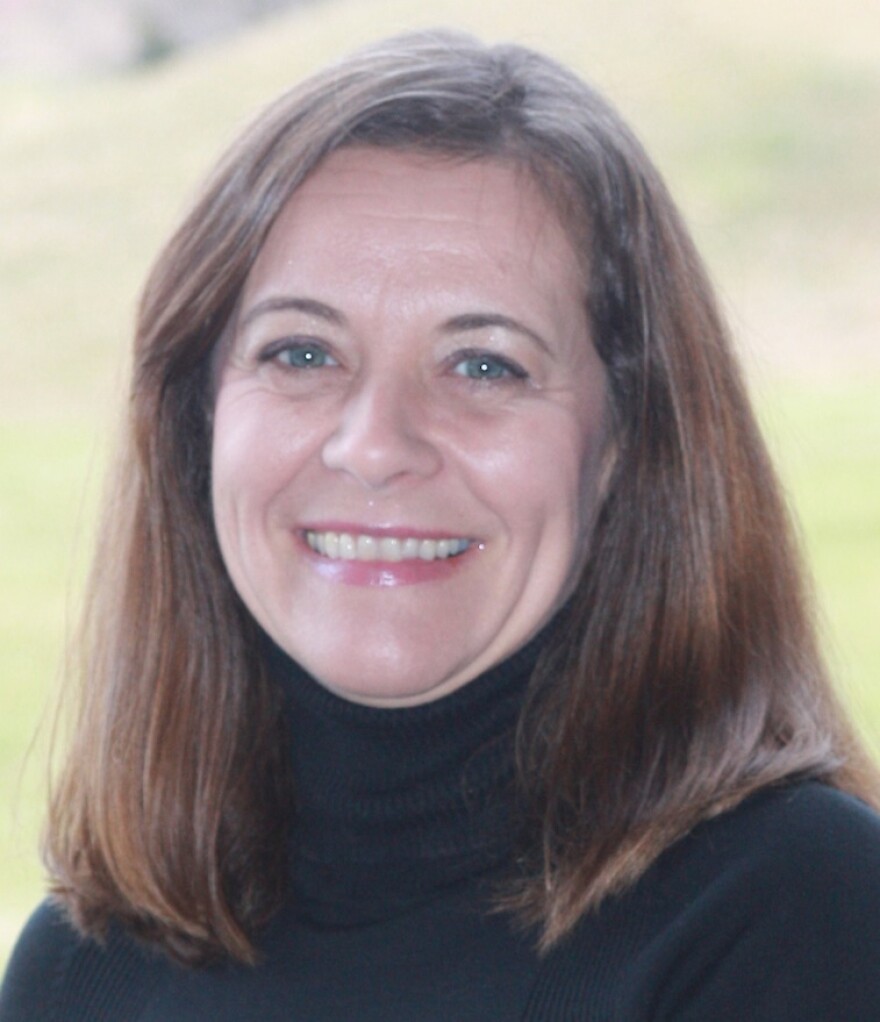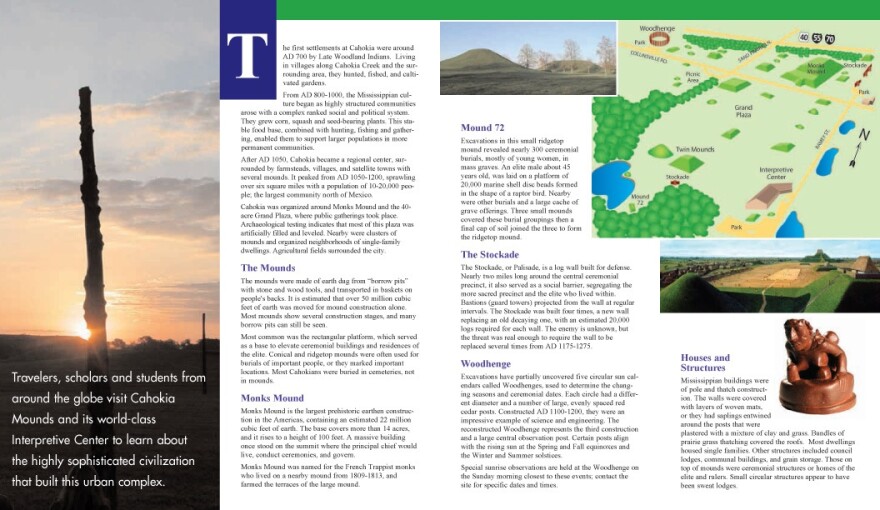After word spread that the cash-strapped Cahokia Mounds Museum Society was crowdfunding to raise $7,500 to print brochures for the storied Illinois landmark -- the largest prehistoric Indian site north of Mexico -- donations poured in from down the road, around the globe and from a mysterious alternate reality.
More than 500 people pledged upward of $8,500 to the campaign on gofundme.com after St. Louis Public Radio’s storyon Feb. 23 made the rounds on social media. Many of the donors are players of Endgame, an alternate reality game created by Google’s Niantic Labs, which adopted the cause because Cahokia Mounds is one of the ancient societies included in the game’s lore.
Most gave just $5 or $10, but within hours the many micro-donations added up to meet the goal -- sort of like the Mississippian Indians who 1,000 years ago formed the earthen mounds of Cahokia one basket of dirt at a time. They crowd built a mighty center of civilization on the Mississippi River floodplain that in A.D. 1200 was larger than London, England.

The fundraising campaign also sparked reaction from people who appreciate the significance of the state historic site in Collinsville that sits next to Interstate 70, within eyeshot of the Gateway Arch. Some posted messages on the museum society’s Facebook page questioning the state’s commitment to Cahokia Mounds, which in 1982 was named a World Heritage Site by UNESCO, the U.N. Educational, Scientific and Cultural Organization. Cahokia Mounds is the only World Heritage Site in Illinois and one of only 22 in the U.S.
“How sad that the state can't or won't fund this site,’’ wrote commenter Laura Sievert. “Without marketing dollars, the site can't become self-sustaining.’’
Lori Belknap, the society’s executive director, said she was surprised and grateful when the Endgame players began driving the contributions upward. They used the hashtag #AncSoc to designate their connection to Ancient Societies, an Endgame website.
Belknap said the campaign touched a nerve.
“It says to me that a lot of people are passionate about our site and are appalled at what’s happening with funding -- and how we’re affected by the state’s politics and budget concerns,’’ she said.
Though the grounds are open seven days a week, the site’s interpretive center has been closed on Mondays and Tuesdays since September. The two-day closure is usually in effect from November through April, but budget cuts forced the site to adopt its winter schedule two months earlier than normal. That, in turn, led to a decline of about 20 percent of expected revenue from the gift shop the society operates in the center.
The state funds the operational expenses of Cahokia Mounds, but the nonprofit society raises about $300,000 a year to pay for educational activities like Kids Day, equinox and solstice observances, arts programs, a lecture series and marketing of the site, Belknap said.
The group also pays for the printing of brochures that provide visitors with a detailed explanation of the ancient mounds. (See some of these interesting facts below.) About 280,000 people visit annually, and about 50,000 take home brochures. Belknap hopes they will share the information and spread awareness of Cahokia Mounds.
The society raises funds through donations and memberships but depends heavily on gift shop sales. Belknap says the worry now is that the two-day closure will be indefinite, which would cut attendance during spring and summer when many schools and tourists visit the site.
She understands the state’s financial woes but thinks the designation as a World Heritage Site should warrant special consideration for Cahokia Mounds.
“I might be biased, but I really think it’s significant and very important to the state,’’ she said.
She would also like the state to do more to market Cahokia Mounds, a historical treasure that many people are unaware of and others take for granted.
“Being down here in southern Illinois has an impact on how we’re supported,’’ she said. “If we were up in Chicago it would be a little different.’’
Belknap says that funds collected in excess of the $7,500 goal have been earmarked for website work, something the society hasn’t had the money to do.
Unlikely allies from an alternate reality
The crowdfunding effort by the Cahokia Mounds Museum Society was slow-going until the Endgame players jumped in. The gofundme.com page, which was posted nearly a month ago, had about $550 in contributions when St. Louis Public Radio highlighted the need behind the campaign.
Brian Rose, community manager at Niantic Labs, says a player alerted Endgame to the story after it triggered a Google alert on Cahokia Mounds. Endgame issued a “call to action,” offering to match contributions of $5 or more marked with the #AncSoc hashtag, until the goal was reached. The players were also added to a beta list for a mobile game app that will launch soon.

Rose noted that some of the players live in the St. Louis area, but most of the contributors live across the United States, and some are from Europe and Australia.
“It was really great to see how quickly people leapt to action on this,’’ he said. “Players wanted to contribute because that’s sort of what the game is all about -- rediscovering and supporting these ancient societies.”
Niantic matched about $2,100 in donations, and author James Frey, who wrote the Endgame trilogy on which the game is based, donated $1,000.
Rose said the challenge fit with the mission statement for Niantic Labs -- “adventures on foot with others” -- which seeks to build real-life experiences into its games.
“We were looking at how people were playing video games and it’s somewhat of a solitary hobby. Usually, people were sitting behind TVs or computer monitors,’’ he said. “We wanted to give people some encouragement or incentive -- some reward to explore neighborhoods around them and to travel more and to rediscover their neighborhoods and find the hidden gems in their towns.”
Rose said that Cahokia Mounds also plays a role in Ingress, another Niantic game where players tag portals, such as public sculptures, landmarks or monuments, that players must physically visit. In January 2013, about 50 players gathered at Cahokia Mounds, the first in what is now a regular series of player meetups. A recent gathering in Tokyo, Japan, drew 5,500 players.
The Cahokia Mounds action was a first for Niantic, but Rose sees potential in connecting players who want to help local neighborhoods or global initiatives – what he refers to as “a force of awesome.”
Should Cahokia Mounds be a national historic site?
Cahokia Mounds is the largest archaeological site in the nation, encompassing about 4,000 acres, although only 2,200 acres are protected by the state.
State Rep. Jerry Costello II, D-Smithton, believes the site, which is a National Historic Landmark, should be a national park.
On Feb. 4, he introduced a resolutionto urge Congress to create the Mississippian Culture National Historical Park, which would encompass Cahokia Mounds and other surviving mounds in the region as a non-contiguous national park. If Congress doesn’t act, the resolution would urge President Barack Obama to issue an executive order designating Cahokia Mounds a National Monument. The bill, which is co-sponsored by state Rep. Jay Hoffman, D-Swansea, has been assigned to the tourism and conventions committee. Costello is a member of that committee.
“I would love to see something more done on a state level,’’ Costello said. “But at this point in time I think everyone’s well aware of the fact that the state of Illinois from a financial standpoint is in a very tough and dire situation -- which is why I’ve asked the president and Congress to elevate Cahokia Mounds to a national historical park.’’
National park status would raise awareness of the site and provide more resources to maintain and protect the mounds, Costello said. He believes the Illinois General Assembly will support the resolution, which he says is intended to send a message to Congress and the president, who is from Illinois.

Belknap says her group would support a national designation, though she doesn’t see it happening in the near future.
Cahokia Mounds is currently managed by the Illinois Historic Preservation Agency, but Gov. Bruce Rauner has proposed placing it and other state historic sites under the Department of Commerce and Economic Opportunity, where they would be administered by the state tourism office.
Rauner’s plan would also have to be approved by the state legislature. Costello says he is studying the proposal but wants to be sure that it would be good move for Cahokia Mounds.
All agree that Cahokia Mounds would benefit from more promotion -- something the state does not fund.
Assistant site manager Bill Iseminger, who has worked at Cahokia Mounds for 40 years, says that visitors frequently tell him that they had no idea of the significance of the site, even though it has been well-documented by national publications and even cable TV channels, such as Discovery and the History Channel.
“People don’t realize that Cahokia Mounds was as big and as important as it was in what we call the prehistoric period, the Mississippian period specifically,’’ he says. “Roughly 1,000 years ago this was the largest Indian settlement in the country -- the largest north of Mexico. But people are not conditioned to think of Indians living in cities. Basically, this was a city.’’
The base of Monks Mound, the largest of the mounds, covers more area than the Great Pyramid of Egypt or the Pyramid of the Sun at Teotihuacan in Mexico.
“I always kind of jokingly say that if we’d had a stone pyramid instead of an earthen mound people would certainly be more aware of us,’’ Iseminger says.
He notes that last fall’s budget cuts were just the most recent in a series of cuts that Cahokia Mounds has faced over the years. The site, which once had 16 employees, now operates with a staff of nine.
Belknap says that Cahokia Mounds is an important piece of Illinois history – and world history. The designation as a World Heritage Site draws visitors from around the world.
“The United Nations felt that our site is significant enough that it’s important to all mankind,’’ she said.
About Cahokia Mounds
Here’s a sampling of some of the facts visitors will find in the Cahokia Mounds brochure:

* Late Woodland Indians first settled in Cahokia about A.D. 700.
* The Mississippian culture developed highly structured communities from A.D. 800-1000. At its peak, Cahokia sprawled across six square miles and had a population estimated at 10,000 to 20,000.
* The largest mound is Monks Mound, which was named for French Trappist monks who lived nearby in the early 1800s. Monks Mound is the largest prehistoric earthen construction in north or south America and contains about 22 million cubic feet of earth. It was the center of Mississippian life.
* The population began to decline about A.D. 1200, and Cahokia was abandoned. Where the Cahokians went remains a mystery.
* The site was named for the Cahokia tribe of the Illinois confederacy, but they did not build the mounds and didn’t arrive in the area until the 1600s.





